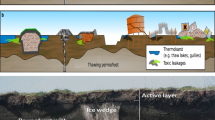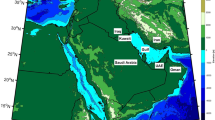Abstract
To estimate atmospheric predictability for multivariable system, based on information theory in nonlinear error growth dynamics, a quantitative method is introduced in this paper using multivariable joint predictability limit (MJPL) and corresponding single variable predictability limit (SVPL). The predictability limit, obtained from the evolutions of nonlinear error entropy and climatological state entropy, is not only used to measure the predictability of dynamical system with the constant climatological state entropy, but also appropriate to the case of climatological state entropy changed with time. With the help of daily NCEP-NCAR reanalysis data, by using a method of local dynamical analog, the nonlinear error entropy, climatological state entropy, and predictability limit are obtained, and the SVPLs and MJPL of the winter 500-hPa temperature field, zonal wind field and meridional wind field are also investigated. The results show that atmospheric predictability is well associated with the analytical variable. For single variable predictability, there exists a big difference for the three variables, with the higher predictability found for the temperature field and zonal wind field and the lower predictability for the meridional wind field. As seen from their spatial distributions, the SVPLs of the three variables appear to have a property of zonal distribution, especially for the meridional wind field, which has three zonal belts with low predictability and four zonal belts with high predictability. For multivariable joint predictability, the MJPL of multivariable system with the three variables is not a simple mean or linear combination of its SVPLs. It presents an obvious regional difference characteristic. Different regions have different results. In some regions, the MJPL is among its SVPLs. However, in other regions, the MJPL is less than its all SVPLs.
Similar content being viewed by others
References
Abramov R, Majda A, Kleeman R. 2005. Information theory and predictability for low-frequency variability. J Atmos Sci, 62: 65–87
Chen B H, Li J P, Ding R Q. 2006. Nonlinear local Lyapunov exponent and atmospheric predictability research. Sci China Ser D-Earth Sci, 49: 11430–11436
Cover T M, Thomas J A. 2006. Elements of Information Theory. 2nd ed. NewYork: John Wiley. 1–12
DelSole T, Tippett M K. 2007. Predictability: Recent insights from information theory. Rev Geophys, 45: RG4002, doi: 10.1029/2006RG000202
DelSole T. 2004. Predictability and information theory. Part I: Measure of predictability. J Atmos Sci, 61: 2425–2440
DelSole T. 2005. Predictability and information theory. Part II: Imperfect Forecast. J Atmos Sci, 61: 3368–3381
Ding R Q, Li J P, Ha K J. 2008a. Nonlinear local Lyapunov exponent and quantification of local predictability. Chin Phys Lett, 25: 1919–1922
Ding R Q, Li J P. 2008b. Comparison of the influences of initial error and model parameter error on the predictability of numerical forecast (in Chinese). Chin J Geophys, 51: 1007–1012
Ding R Q, Li J P, Ha K J. 2008c. Trends and interdecadal changes of weather predictability during 1950s–1990s. J Geophys Res, 113: D24112, doi: 10.1029/2008JD010404
Ding R Q, Li J P. 2007. Nonlinear finite-time Lyapunov exponent and predictability. Phys Lett A, 364: 396–400
Ding R Q, Li J P. 2009a. Application of nonlinear error growth dynamics in studies of atmospheric predictability (in Chinese). Acta Meteor Sin, 67: 241–249
Ding R Q, Li J P. 2009b. The temporal-spatial distributions of weather predictability of different variables (in Chinese). Acta Meteor Sin, 67: 343–354
Ding R Q, Li J P. 2011a. Comparisons of two ensemble mean methods in measuring the average error growth and the predictability. Acta Meteor Sin, 25: 395–404
Ding R Q, Li J P. 2011b. Estimate of the predictability of boreal summer and winter intraseasonal oscillations from observations. Mon Weather Rev, 139: 2421–2438
Duan W S, Mu M. 2009a. Conditional nonlinear optimal perturbation: applications to stability, sensitivity, and predictability. Sci China Ser D-Earth Sci, 52: 883–906
Duan W S, Liu X, Zhu K, et al. 2009b. Exploring the initial error that causes a significant spring predictability barrier for El Nino events. J Geophy Res, 114: C04022, doi: 10.1029/2008JC004925
Duan W S, Zhang R. 2010. Is model parameter error related to spring predictability barrier for El Nino events?. Adv Atmos Sci, 27: 1003–1013
Duan W S, Yu Y S, Xu H, et al. 2013a. Behaviors of nonlinearities modulating the El Niño events induced by optimal precursory disturbance. Clim Dyn, 40: 1399–1413, doi: 10.1007/s00382-012-1557-z
Duan W S, Wei C. 2013b. The ‘spring predictability barrier’ for ENSO predictions and its possible mechanism: Results from a fully coupled model. Int J Climatol, 33: 1280–1292, doi: 10.1002/joc.351
Duan W S, Zhou F. 2013. Nonlinear forcing singular vector of a two-dimensional quasi-geostrophic model. Tellus-A, 65: 18452
Kleeman R. 2002. Measuring dynamical prediction utility using relative entropy. J Atmos Sci, 59: 2057–2072
Kullback S, Leibler R A. 1951. On information and sufficiency. Ann Math Stat, 22: 79–86
Leung L Y, North G R. 1990. Information theory and climate prediction. J Clim, 3: 5–14
Li A B, Zhang L F, Wang Q L, et al. 2013. Information theory in nonlinear error growth dynamics and its application to predictability: Taking the Lorenz system as an example. Sci China Earth Sci, 56: 1413–1421
Li J P, Ding R Q, Chen B H. 2006. Review and prospect on the predictability study of the atmosphere (in Chinese). In: National Natural Science Foundation Committee, ed, Review and Prospects of the Developments of Atmosphere Science in Early 21st Century. Beijing: China Meteorology Press. 96–103
Li J P, Ding R Q. 2008. Temporal-spatial distribution of predictability limit of short-term climate (in Chinese). Chin J Atmos Sci, 32: 975–986
Li J P, Ding R Q. 2011. Tempeoral-spatial distribution of atmospheric predictability limit by local dynamical analogs. Mon Weather Rev, 139: 3265–3283
Li J P, Ding R Q. 2012. Temporal-spatial distribution of the predictability limit of monthly sea surface temperature in the global oceans. Int J Climatol, doi: 10.1002/joc.3562
Li J P, Zeng Q C, Chou J F. 2000. Computational uncertainty principle in nonlinear ordinary differential equations I: Numerical results. Sci China Ser E, 43: 449–460
Li J P, Zeng Q C, Chou J F. 2001. Computational uncertainty principle in nonlinear ordinary differential equations II: Theoretical analysis. Sci China Ser E, 44: 55–74
Lorenz E N. 1982. Atmospheric predictability experiments with a large numerical model. Tellus, 34: 505–513
Mu M, Duan W S, Wang B. 2003a. Conditional nonlinear optimal perturbation and its applications. Nonlinear Process Geophys, 10: 493–501
Mu M, Duan W S, Wang J C. 2002. The predictability problems in numerical weather and climate prediction. Adv Atmos Sci, 19: 191–204
Mu M, Duan W S. 2003b. A new approach to studying ENSO predictability: Conditional nonlinear optimal perturbation. Chin Sci Bull, 48: 1045–1047
Mu M, Duan W S. 2005. Conditional nonlinear optimal perturbation and its application to the studies of weather and climate predictability. Chin Sci Bull, 50: 2401–2407
Mu M, Duan W, Wang Q, et al. 2010. An extension of conditional nonlinear optimal perturbation approach and its applications. Nonlinear Process Geophys, 12: 211–220
Mu M, Jiang Z N. 2008. A new approach to the generation of initial perturbations for ensemble prediction: Condition nonlinear optimal perturbation. Chin Sci Bull, 53: 2062–2068
Mu M, Zhou F F, Wang H L. 2009. A method to identify the sensitive areas in targeting for tropical cyclone prediction: Conditional nonlinear optimal perturbation. Mon Weather Rev, 137: 1623–1639
Reichler T, Roads J O. 2004. Time-space distribution of long-Rang Atmospheric predictability. J Atmos Sci, 61: 249–263
Roulston M, Smith L. 2002. Evaluating probabilistic forecasts using information theory. Mon Weather Rev, 130: 1653–1660
Schneider T, Griffies S M. 1999. A conceptual framework for predictability studies. J Clim, 12: 3133–3155
Tang Y M, Lin H, Derome J, et al. 2007. A predictability measure applied to seasonal predictions of the Arctic Oscillation. J Clim, 20: 4733–4750
Tang Y M, Lin H, Moore A M. 2008. Measuring the potential predictability of ensemble climate predictions. J Geophys Res, 113: D04108, doi: 10.1029/2007JD008804
Yang X Q, Anderson J L, Stern W F. 1998. Reproducible forced modes in AGCM ensemble integration and potential predictability of atmospheric seasonal variations in the extratropics. J Clim, 11: 2942–2959
Yu Y, Mu M, Duan W. 2012. Does model parameter error cause a significant “Spring Predictability Barrier” for El Niño events in the Zebiak-Cane Model?. J Clim, 25: 1263–1277
Ziehmann C, Smith L, Kurths J. 2000. Localized lyapunov exponents and prediction of predictability. Phys Lett A, 271: 237–251
Author information
Authors and Affiliations
Corresponding author
Rights and permissions
About this article
Cite this article
Li, A., Zhang, L. & Wang, Q. Estimation of atmospheric predictability for multivariable system using information theory in nonlinear error growth dynamics. Sci. China Earth Sci. 57, 1907–1918 (2014). https://doi.org/10.1007/s11430-014-4823-6
Received:
Accepted:
Published:
Issue Date:
DOI: https://doi.org/10.1007/s11430-014-4823-6




